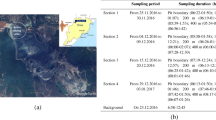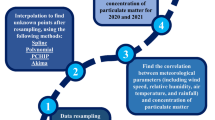Abstract
Air pollution in mining area is one of the critical concerns because of the generation of large amount of the particulate matters (PM) in opencast mining operations. The emission of PM in the air not only deteriorates the surrounding environment but also impacts adversely to the human health. The majority of the PM particles in opencast mining comprise PM2.5 and PM10. The assessment of the limit of the PM particles is very important as it helps in environmental impact analysis (EIA/EMP) and prediction of possible dust generation (PM particles) for any project to be established. In this paper, a model was developed that is capable to predict the respirable dust particulate concentration in the ambient air at various locations near and away from the dust-generating source, especially from a drilling operation in Indian opencast mines. The modeling was carried out using three different methods, i.e., “SPSS,” “R,” and artificial neural network (ANN) methods. Results from these developed models were compared with the US Environmental Protection Agency (USEPA) model for its validity. The predicted values from the developed model showed good correlation and the least variation from the field-monitored values, indicating better accuracy, compared with other models.











Similar content being viewed by others
References
Abderrahim H, Chellali MR, Hamou A (2016) Forecasting PM10 in Algiers: efficacy of multilayer perceptron networks. Environ Sci Pollut Res 23:1634–1641
Abdul-Wahab SA (2001) IER photochemical smog evaluation and forecasting of short-term ozone pollution levels with artificial neural networks. Trans Inst Chem Eng (Trans IchemE) Part B: Proc Saf Environ Prot 79:117–128
Abdul-Wahab SA, Bouhamra W, Ettouney H, Sowerby B (1996) A statistical model for predicting ozone levels in the Shuaiba industrial area. Kuwait Environ Sci Pollut Res (ESPR) 3:195–204
Abdul-Wahab SA, Al-Rubiei R, Al-Shamsi A (2003) A statistical model for predicting carbon monoxide levels. Int J Environ Pollut (IJEP) 19:209–224
Abdul-Wahab SA, Bakheit CS, Al-Alawi SM (2005) Principal component and multiple regression analysis in modeling of ground-level ozone and factors affecting its concentrations. Environ Model Softw 20:1263–1271
Arup (1995) The environmental effects of dust from surface mineral workings. HMSO London PECD 7/1/468
Asif Z, Chen Z, Yi H (2018) Air quality modeling for effective environmental management in the mining region. J Air Waste Manage Assoc 68:1001–1014
Balkau F (1993) Pollution prevention and abatement guidelines for the mining industry. UNEP IE/PAC Paris 2nd Draft
Chellali MR, Abderrahim H, Hamou A, Nebatti A, Janovec J (2016) Artificial neural network models for prediction of daily fine particulate matter concentrations in Algiers. Environ Sci Pollut Res 23:14008–14017
Cole CF, Zapert JG (1995) Air quality dispersion model validation at three stone quarries. Englewood, CO: TRC Environmental Corp, TRC project No. 14884 for the National Stone Association, Washington DC
Cowherd C Jr (1979) Measurements of fugitive dust emissions from haul roads. Report No. EPA-600/7–79–182 Research Triangle Park. NC: USEPA, Industrial Environmental Research Laboratory
Gardner MW, Dorling SR (1998) Artificial neural networks (the multilayer perceptron) a review of applications in atmospheric sciences. Atmos Environ 32:2627–2636
Gokhale S, Khare M (2004) A review of deterministic, stochastic and hybrid vehicular exhaust emission models. Int J Transp Manag 2:59–74
Hsu KJ (1992) Time series analysis of the interdependence among air pollutants. Atmos Environ 26:491–503
Korhonen A, Lehtomaki H, Rumrich I, Karvosenoja N, Paunu VV, Kupiainen K, Sofiev M, Palamarchuk Y, Kukkonen J, Kangas L, Karppinen A, Hanninen O (2019) Influence of spatial resolution on population PM2.5 exposure and health impacts. Air Quality. Atmos Health 12:705–718
Mehdipour V, Stevenson DS, Memarianfard M, Sihag P (2018) Comparing different methods for statistical modeling of particulate matter in Tehran, Iran. Air Qual Atmos Health 10:1155–1165
Palanivelraja S, Chockalingam MP (2008) Performance evaluation of USEPA ISCST3 model in the ambient environment of Neyveli Air Basin. IJEP 29:316–322
Patra AK, Gautam S, Majumdar S, Kumar P (2016) Prediction of particulate matter concentration profile in an opencast copper mine in India using an artificial neural network model. Air Qual Atmos Health 9:697–711
Author information
Authors and Affiliations
Corresponding author
Additional information
Publisher’s note
Springer Nature remains neutral with regard to jurisdictional claims in published maps and institutional affiliations.
Rights and permissions
About this article
Cite this article
Nagesha, K.V., Kumar, H. & Muralidhar Singh, M. Development of statistical models to predict emission rate and concentration of particulate matters (PM) for drilling operation in opencast mines. Air Qual Atmos Health 12, 1073–1079 (2019). https://doi.org/10.1007/s11869-019-00723-7
Received:
Accepted:
Published:
Issue Date:
DOI: https://doi.org/10.1007/s11869-019-00723-7




